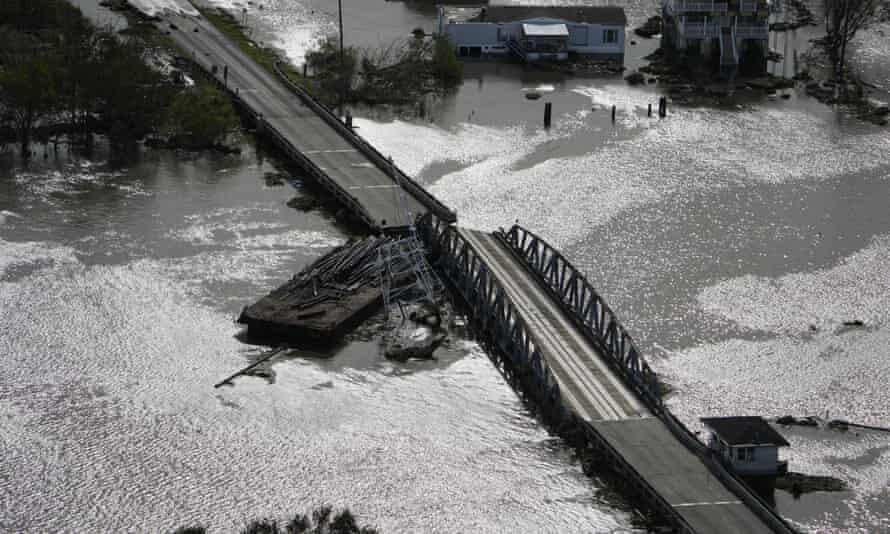
The deaths in Mississippi took the toll from Ida to four. In Louisiana, one person died in floodwaters and one was killed by a falling tree.
In Slidell, Louisiana, crews were searching for a 71-year-old man whose wife said he was attacked by an alligator in the floodwaters. She pulled him to the steps of the home and paddled away to get help, she said, but when she returned, he was gone.
New Orleans woke to a second day without power on Tuesday after Ida ripped through south-east Louisiana, causing severe damage and widespread outages. Residents turned to concerns over evacuation and resources.
As the temperature nudged 90F (32C), the National Weather Service (NWS) issued a heat advisory, saying: "The absence of some basic services amid high heat indices can make the situation very acute."
Hundreds of thousands sweltered with no electricity and no tap water. People cleared rotting food from refrigerators. Neighbours shared generators and used buckets of swimming pool water to bathe or to flush toilets. Long lines formed at the few gas stations that had fuel and generator power to pump it.
Authorities had provided little concrete guidance on when power might return, but energy provider Entergy has warned it could be up to three weeks.
"I can't tell you when the power is going to be restored," Louisiana's governor, John Bel Edwards, told reporters on Monday. "I can't tell you when all the debris is going to be cleaned up and repairs made. But what I can tell you is we are going to work hard every day to deliver as much assistance as we can."
The governor said 25,000 utility workers were on the ground to help restore electricity, with more on the way.
Gen Daniel Hokanson, chief of the national guard, said "more than 6,000 national guard members from multiple states" were "assisting with rescue and relief efforts" in Louisiana, Mississippi and surrounding areas.
In Mississippi, authorities said the drivers who died on Monday night may not have seen that the roadway had disappeared.
"Some of these cars are stacked on top of each other," said Cal Robertson of the Mississippi highway patrol.
Seven vehicles were involved, including a motorcycle. A crane was brought in to lift them out of the hole.
WDSU-TV reported that state troopers, emergency workers and rescue teams responded to Highway 26 west of Lucedale, about 60 miles north-east of Biloxi, to find both the east and westbound lanes collapsed. Robertson said the hole was about 50ft to 60ft long and 20ft to 30ft deep.
The identities and conditions of those who survived the accident were not immediately released.
More than 8in of rain fell in the area during Ida, according to the National Weather Service.
Ida blasted ashore on Sunday as a category 4 storm, one of the most powerful ever to hit the US mainland, knocking out power, blowing roofs off buildings and reversing the flow of the Mississippi River.
In Mississippi's south-western corner, entire neighbourhoods were surrounded by floodwaters and many roads were impassable. Several tornadoes were reported, including a suspected twister in Saraland, Alabama, that ripped part of the roof off a motel and flipped an 18-wheeler, injuring the driver.
Joe Biden met virtually on Monday with Mississippi's governor, Tate Reeves, along with Louisiana's Edwards, and mayors from cities and parishes most affected by Hurricane Ida. The president received an update on the storm's impact and discussed how the federal government can provide assistance.
"We are closely coordinating with state and local officials every step of the way," Biden said.
On Tuesday the remnants of Hurricane Ida dumped rain from Gulf coast states into New England.
Weakened to a tropical depression with top sustained winds of 30mph, Ida was centered over northern Mississippi and Tennessee. The NWS said flash flooding was most likely in central Pennsylvania, northern West Virginia and western Maryland, where 6in to 10in could fall.
Forecasters also warned of higher wind gusts, and said Ida was most likely to spawn tornadoes in eastern Alabama, western Georgia and the Florida Panhandle.
Meanwhile, forecasters have identified a new storm system out to sea. Kate was loosely organized and should remain far from shore in the central Atlantic, the US National Hurricane Center in Miami reported. Forecasters said another tropical depression was forming off the coast of Africa, blowing across the Atlantic a couple of hundred miles west-south-west of the coast of Guinea.



Reader Comments
to our Newsletter